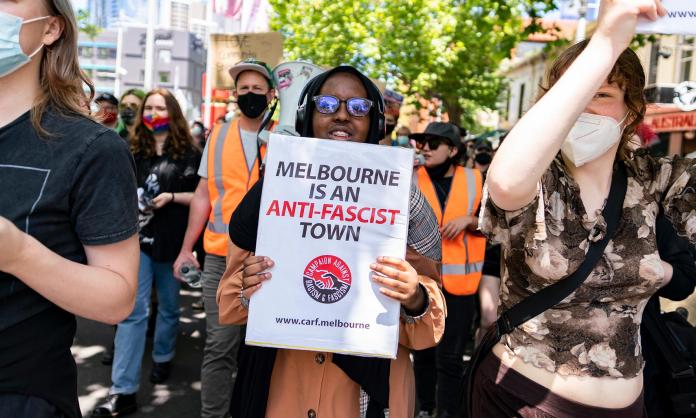Before the pandemic, it would have been hard to predict that mass far-right mobilisations would dominate the streets of Australia’s capital cities. But they have, and they threaten to continue.
The largest of these were held on 20 November, with tens of thousands mobilising across the country. These gathering forces are led by a highly motivated far right and have galvanised every significant fascist organisation in Australia.
Until now, these forces and the broad right-wing coalition that marches with them dominated the streets without any nationally organised pro-health, anti-fascist opposition.
On 20 November, left-wing activist groups across the country decided to draw a line in the sand. More than 1,000 anti-fascists protested in Melbourne and more than 100 in each of Sydney, Brisbane and Perth.
The rallies were important. For the first time, newspaper articles across the country could say that there were people protesting for COVID health measures—protesting to save lives and protesting in solidarity with the health workers who have been smashed over the course of the pandemic.
The dominance of the far right on the streets has allowed the “freedom” movement to present itself as insurgent and radical, when in fact some of the most reactionary forces in Australian society are bankrolling it. Having counter-mobilisations, even if small, can start to chip away at that image. The streets need to be made places of political contestation again.
Having rallies that are clear and sharp about the politics of those they are opposing also matters. It matters to have anti-fascist activists on the nightly news talk about the Trump flags, the COVID denial and the Nazis that are part of the “freedom” movement.
Rather than just Labor politicians, police chiefs or liberal journalists arguing that the people who march in the rallies are fascist, there were left-wing activists making the argument. This is crucial. It opens up a space to organise for left-wing people concerned about the growth of the far right.
While Daniel Andrews or Mark McGowan might decry the anti-vaxxers for being, in McGowan’s words, “dangerous urban terrorists”, they have no intention of building an active anti-fascist movement, let alone a broader and more radical left that can fight for workers’ rights, a better funded healthcare system and a decent world. Anti-fascist and pro-health rallies can start to do this.
We know that the numbers on our side were small, both in comparison to the far-right rallies but also in comparison to the pro-health sentiment in society. Australia has some of the highest vaccination rates in the world, and polls indicate broad and enduring support for public health measures (and the politicians advocating these measures).
The challenge for the anti-fascist and pro-health left is to convince more of these people to mobilise actively. There is a big audience out there, and it is important that we make a start.
To this end, the anti-fascist movement needs more organisations—more trade unions, more political parties like the Greens or branches of the ALP, more campaign groups—to get on board.
Most movements have started with a determined minority.
World War One initially was popular in Australia. But a minority opposed it, and as the horrors of the war were revealed, a mass movement developed from foundations laid by early anti-war activists. The anti-war movement eventually defeated conscription.
The Australian movement against racist apartheid in South Africa began with demonstrations in their hundreds, and over time blossomed into a major campaign of hundreds of thousands across the country, involving union strikes and riotous actions against South African sporting teams.
In the 1990s, the election of Pauline Hanson was initially greeted with dismay and despair. A minority of activists felt the need to do something. And that something, by being bold and defiant and determined, gave a lead. It gave confidence to a broader layer of people across the country to oppose Hanson and everything she stood for. Eventually the anti-Hanson campaign organised tens of thousands of migrants, Indigenous people and students in a movement that led to Hanson’s defeat.
We have no idea if the anti-fascist pro-health mobilisations can grow similarly or have the same effect. But we have to try. As Melbourne anti-fascist organiser Nahui Jimenez said:
“The so-called ‘freedom movement’ has broad appeal—it unites anti-vaxxers, religious conservatives, the far right and fascists. This means we need to confront them in a united way with a similarly broad coalition of the left.”








